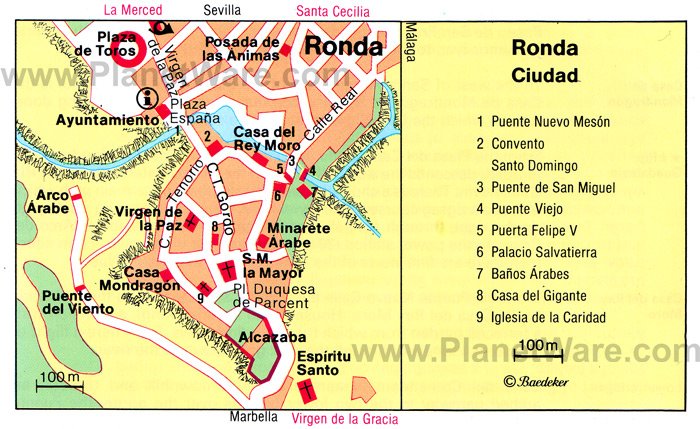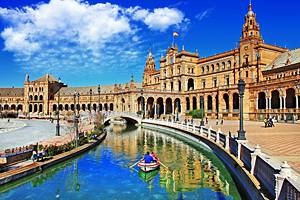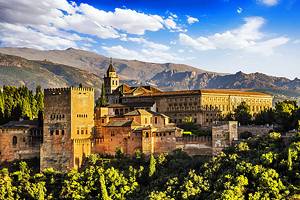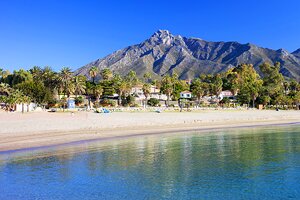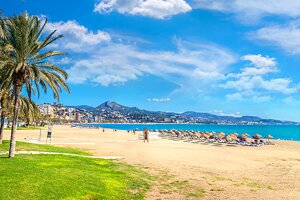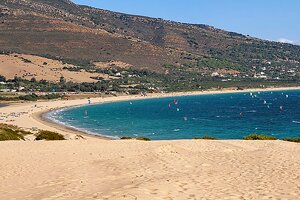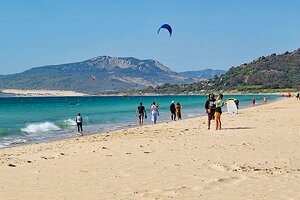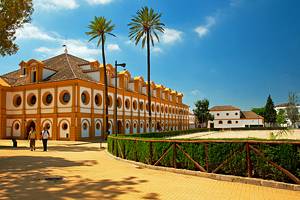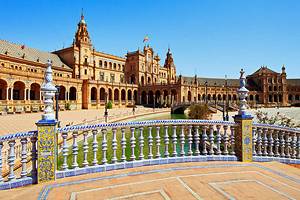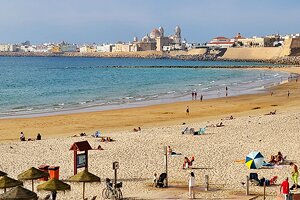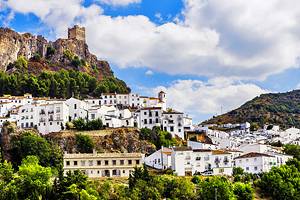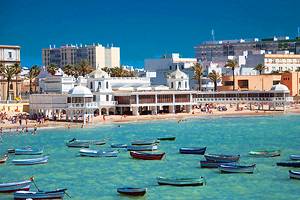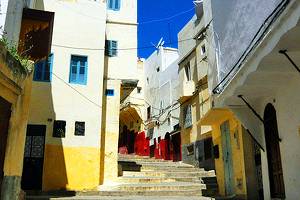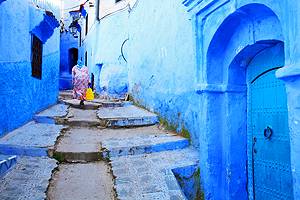Attractions & Things to Do in Ronda
Authors Michael and Lana Law visited Ronda as part of a two month trip through southern Spain.
Perched on a plateau overlooking a sheer cliff, Ronda epitomizes the drama of Andalusia. The setting is truly spectacular, and the culture (famed for bullfighting and bandits) is just as exciting. Ernest Hemingway set some scenes of his novel For Whom the Bell Tolls in Ronda, immortalizing the special aura of this place.
The most amazing sight is the Puente Nuevo bridge, which straddles the Tajo de Ronda, a 100-meter-deep gorge that is classified as a Monumento Natural de Andalucía (Natural Monument of Andalusia). Another major attraction in Ronda is the Plaza de Toros, Spain's second oldest bullring, which is still used to stage bullfights.
The quaint old streets and whitewashed buildings of La Ciudad, the old Moorish town, are enchanting and a fun place to spend some time wandering around.
Learn about the best places to visit in this breathtaking city with our list of the top things to do in Ronda.
- Puente Nuevo (New Bridge)
- Plaza de Toros
- Baños Árabes (Moorish Baths)
- Alameda del Tajo
- La Casa del Rey Moro
- Museo Arqueológico Municipal
- Museo Lara
- La Ciudad: The Old Moorish Town
- The Lower Bridges: Puente Viejo and Puente de San Miguel
- Plaza del Socorro
- Iglesia de Santa María La Mayor
- Puerta de Almocábar
- Celebrating Heritage: Ronda's Annual Festivals
- Where can you park in Ronda?
Puente Nuevo (New Bridge)
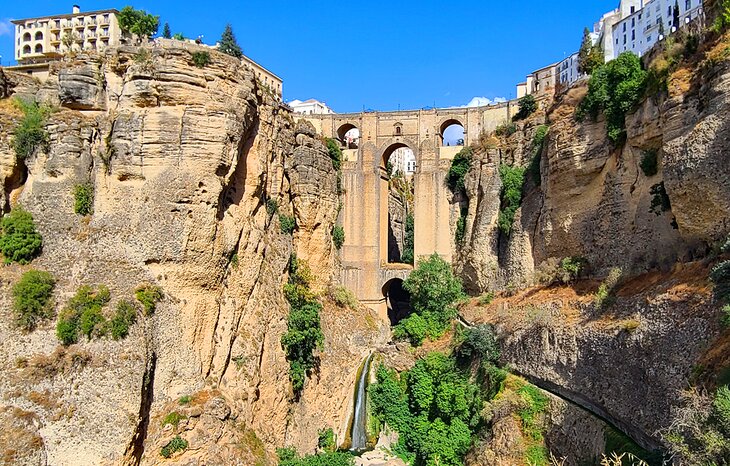
The Puente Nuevo is the most emblematic monument of Ronda. Built in 1788, the bridge is a feat of engineering and a masterpiece of stone masonry. The 70-meter-long bridge crosses the Tajo de Ronda gorge at its narrowest point and reaches a height of 98 meters from the bottom of the ravine.
The bridge connects La Cuidad, the historic old Moorish town of Ronda, with El Mercadillo (Market Quarter), the "modern" part of town. From the bridge, the views of the gorge and the Río Guadalevín are stunning.
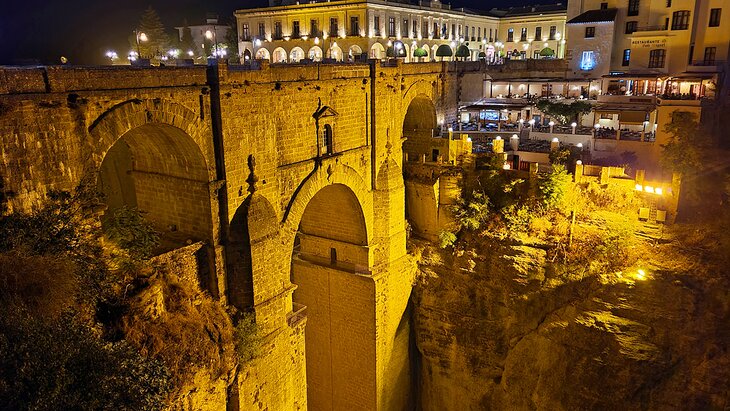
One of the most popular things to do in Ronda and a good way to see the bridge is to walk down the steep trail on the west side of the Puente Nuevo to the lookout below the bridge. This is where you'll be able to see the famous view of the bridge and waterfalls below. The lookout area from this trail does not have barriers along the cliff edge. Families with kids should be mindful.
On the east side of the bridge are tiered terraces where you can enjoy food and drink. You can reach this area by entering through the Hotel Don Miguel immediately next to the bridge.
Plaza de Toros

The second oldest bullfighting ring in Spain, the Plaza de Toros is a living testament to the region's most famous custom. Ronda was the home of the Romero dynasty of matadors (Francisco, Juan, and Pedro), who developed the rules of the present-day bullfight in the 18th and 19th centuries.
This site is the main tourist attraction in El Mercadillo and was immortalized by Hemingway in his novel Death in the Afternoon. The Mercadillo quarter is separated from La Cuidad (the old Moorish town) by the Tajo de Ronda canyon.
Built in 1785, the Plaza de Toros is a monumental bullring with a 66-square-meter arena and two tiers of arcaded galleries for seating spectators. The covered galleries feature elegant arches of Tuscany columns, as well as Royal Box Seats.
The Plaza de Toros no longer hosts bullfights, except once a year during the Feria de Pedro Romana festival in September. The festival (also called the Feria Goyesca) includes parties, a costumed parade, music concerts, and fireworks. The festival's highlight is a traditional bullfight called the Corrida Goyesca in which the matador wears an ornate costume of the Goya era (late 18th century).
The Plaza de Toros bullring is part of the Real Maestranza de Caballería (Royal School of Cavalry) and is open to the public for visits year-round every day. The Real Maestranza de Caballería site includes the bullring, the Museo Taurino (Bullfighting Museum), a Riding School, the Royal Harness and Livery Collection, a gift shop, and a cafeteria.
Address: Real Maestranza de Caballería, Calle Virgen de la Paz, Ronda
Baños Árabes (Moorish Baths)
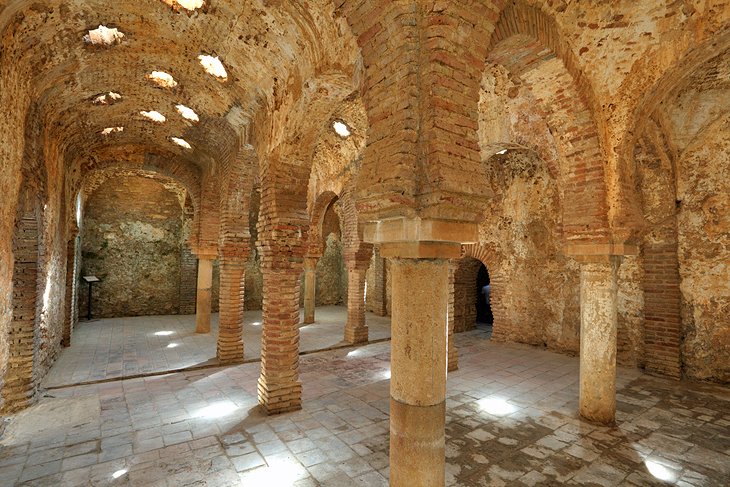
A hidden treasure of Ronda, these 13th- to 15th-century thermal baths are considered the best-preserved Moorish Baths in Spain. The Baños Arabes are near the Puente Viejo in the Barrio de San Miguel just outside of La Cuidad.
The baths were built along the Arroyo de las Culebras (Snakes' Stream), a source of spring water, which has a perfectly preserved water wheel from the Moorish era.
Similar to ancient Roman baths, the complex has cold, warm, and hot baths (the heating system was entirely hydraulic). However, the architecture exemplifies Moorish design with a central hall and two other sections separated by the characteristic Islamic-style horseshoe-shaped arches. The barrel-vaulted ceiling features beautiful star-shaped skylights.
The baths are no longer in use, but the site is open to the public for visits.
Address: Calle Molino de Alarcón, Ronda
Alameda del Tajo
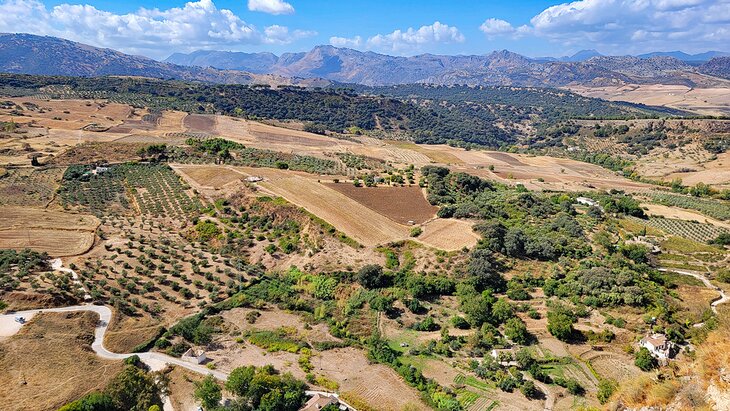
A beautiful 19th-century public park, the Alameda del Tajo is next to the Plaza de Toros overlooking the Tajo de Ronda gorge. Filled with towering pines, this lush and spacious park provides a welcome shady spot to relax on warm days.
Many local families take their evening stroll (paseo) at this park along the tranquil, tree-lined paths. A duck pond adds to the peaceful environment. Some areas of the park offer magnificent panoramic views of the Ronda landscapes.
The Alameda del Tajo is near two noteworthy hotels. The four-star Hotel Catalonia Reina Victoria is found near the ledge of the plateau on the Calle Jerez.
Just a five-minute walk away from the park is the Parador de Ronda on the Plaza España. This stylish four-star hotel boasts spectacular views of the Tajo de Ronda canyon, along with wonderful amenities: an outdoor swimming pool, gardens, concierge services, and two gourmet restaurants.
La Casa del Rey Moro
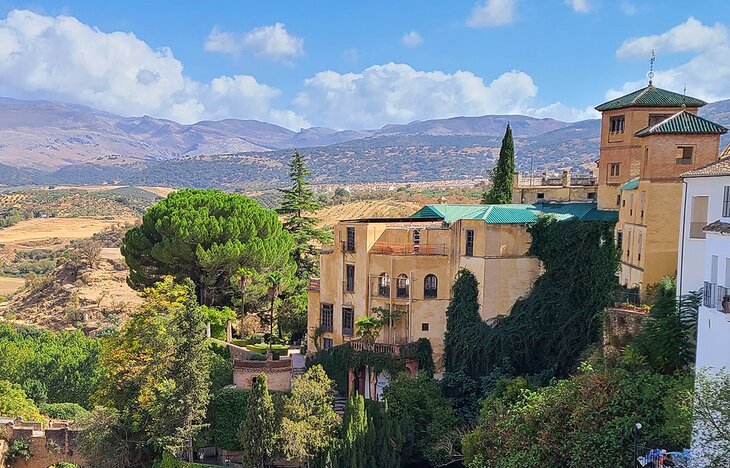
The Casa del Rey Moro is an 18th-century mansion built on the site of a 14th-century Moorish water mine. Despite its name, which translates to "House of the Moorish King," the mansion was actually the residence of the aristocratic Salvatierra family and later the Duchess of Parcent who renovated the building in neo-Mudéjar style.
To find the gardens, take the flight of stairs decorated with ceramics. A breathtaking outdoor space on three tiers, the gardens were designed in 1912 by French landscape gardener Jean Claude Nicolas Forestier.
From the three garden terraces, you can admire sweeping views of Ronda's stunning natural landscape. The gardens also feature gushing fountains and soothing water lanes similar to the gardens of the Alhambra. Colorful flowers and ponds filled with water lilies add to the beauty.
A flight of 200 steps descends from the gardens through the rock to the Guadalevin River at the bottom of El Tajo gorge.
Currently, the Casa del Rey Moro is undergoing renovations and is not open to the public. However, the gardens are open year-round; entrance requires an admission fee.
Address: Calle Cuesta de Santo Domingo, Ronda
Museo Arqueológico Municipal
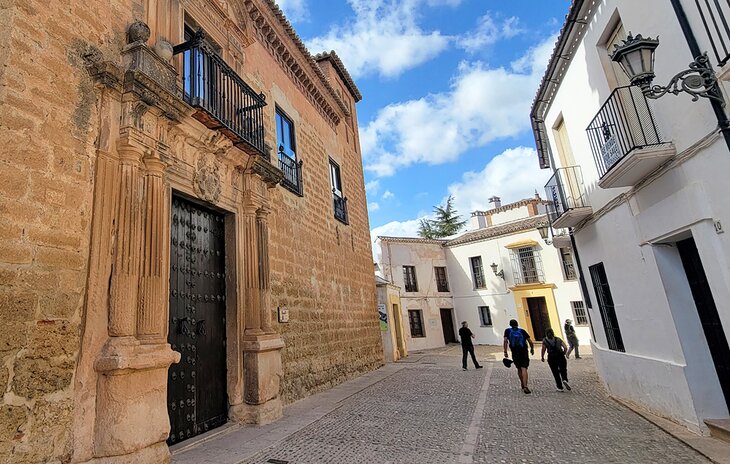
The Museo Arqueológico Municipal (Municipal Museum of Archaeology) is housed in the Palacio de Mondaragón. Dating to the 14th-century, this splendid palace blends Mudéjar and Renaissance architectural elements.
The museum itself contains exhibits that span prehistory through Roman times, focusing on those discoveries made in the region. Prehistoric sections explore the lives of cave-dwelling hunter-gatherers, as well as the early innovations of the first societies, from earthenware to metallurgy.
There is also a section dedicated to the first Iberian states and the later Roman influences, displaying many of the archaeological finds made in nearby Acinipo and Arunda. Exhibits display statues, coins, and other items.
Address: Plaza Mondragón, Ronda
Official site: www.museoderonda.es
Museo Lara
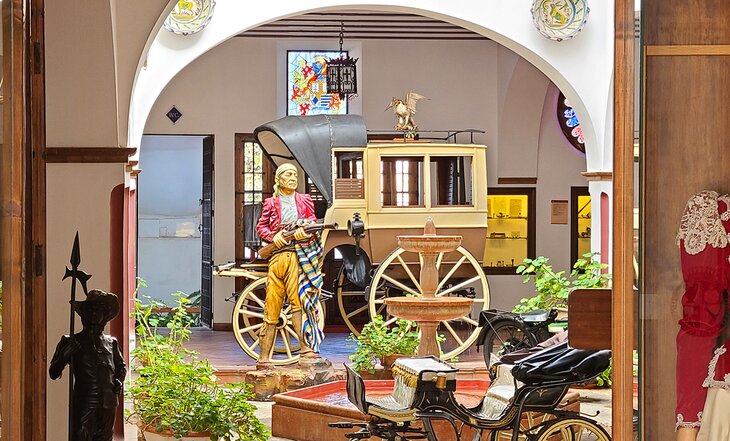
Located in the Casa Palacio de los Condes de las Conquistas in the Old Town, the Museo Lara is a history museum with an eclectic variety of specialized collections. There are rooms dedicated to antique scientific instruments, weapons, and clocks.
A particularly interesting exhibit focuses on the Holy Inquisition. The selection of artifacts represents various torture instruments, including hanging cages, an iron maiden, and a cradle of Judas. The Witchcraft exhibit showcases historic witchcraft practices and potions.
Address: 29 Calle Armiñán, Ronda
Official site: www.museolara.org
La Ciudad: The Old Moorish Town
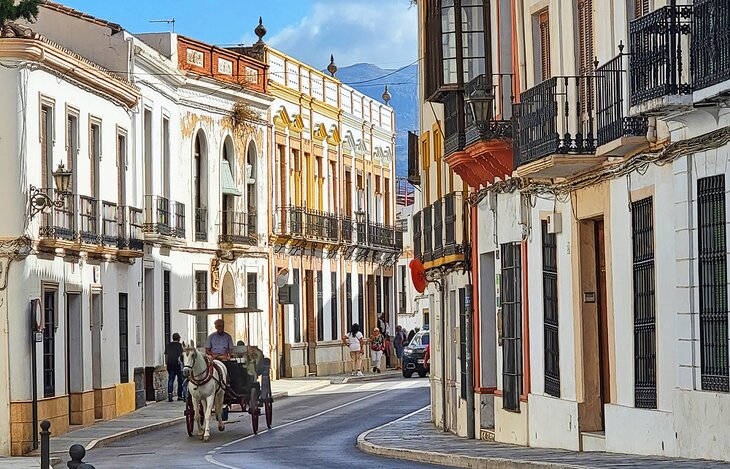
The medieval Moorish town is the soul of Ronda with its historic squares, narrow pedestrian streets and charming whitewashed houses. La Cuidad has an Old World European charm combined with some of the ambience of a medina (walled town of North Africa). This is the area where you will find most of the town's cultural attractions.
On the picturesque Plaza de la Duquesa de Parcent, the Iglesia Santa María la Mayor is a church that was converted from a former Mosque. The church has preserved four of the Moorish domes, however the interior is Gothic with a Plateresque-style Capilla Mayor (chapel) added in Christian times. The sanctuary boasts exquisite Renaissance choir stalls and a Moorish mihrab (prayer niche indicating the direction of Mecca).
To the west of Santa María la Mayor Church, at the edge of the plateau, is the Palacio de Mondragón, which houses the Municipal Museum of Archaeology. This Moorish and Renaissance-style palace once provided luxurious accommodations for the Catholic Monarchs.
Nearby is Casa Juan Bosco, a 20th-century palace set in beautiful gardens.
On the Calle Armiñán, the Museo del Bandolero (Museum of Bandits) illustrates the history of the 19th-century bandits who lived in the mountains around Ronda.
The Lower Bridges: Puente Viejo and Puente de San Miguel
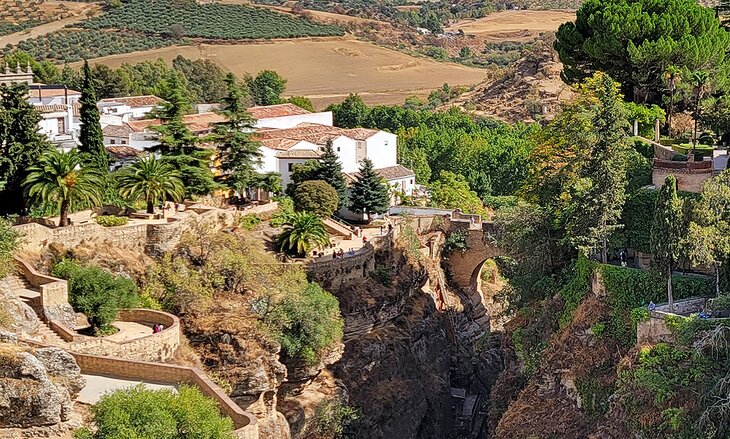
Ronda's two lower bridges over the gorge are reached by taking Calle del Comandante Linares downhill and through an arched gateway. Here, stand the 16th-century Puente Viejo and the imposing Puente de San Miguel. The San Miguel Bridge is also known as the Roman Bridge, even though it was not built during the ancient Roman era.
The area around the lower bridges is popular with hikers and nature lovers. A walking trail through the gorge crosses the Puente de San Miguel. Cyclists can take a biking trail through the rugged landscape that winds up at the Puente Viejo.
Plaza del Socorro
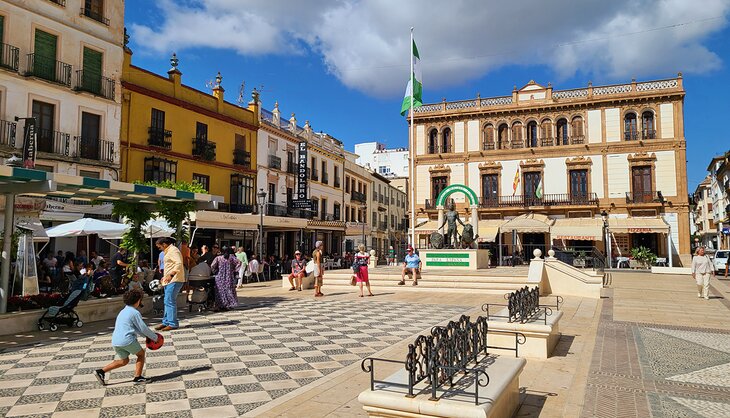
If, after all your wandering around Ronda, you need a place to sit down and rest, make your way to the Plaza del Socorro. A central fountain spouts water in the center, while around the sides of the square are restaurants, all with large, shaded patios.
As you sip your coffee and recharge, your vista will include impressive 18th-century buildings and the colorful Iglesia del Socorro.
If you are lucky enough to be staying the night in Ronda, return her in the evening. The square transforms to a lively spot, with locals meeting up for dinner with friends at some of Ronda's best restaurants. All the buildings are softly lit, and the place has a somewhat magical feel, which makes you want to linger.
A small parking garage is located right under the square, and although relatively expensive, it is exceptionally well located to all the major attractions.
Iglesia de Santa María La Mayor
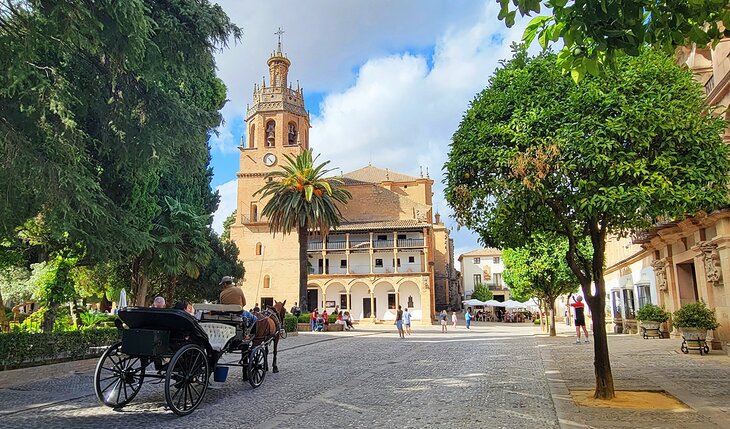
Located in the same square as Ronda's Town Hall (Plaza Duquesa de Parcent), this historic church is locally known as the Iglesia de Santa María de la Encarnación la Mayor. The church features many beautiful architectural details and artwork, as well as numerous artifacts and statues that are part of the annual Semana Santa celebrations.
The site has long been home to places of worship, beginning as a pre-Christian Roman altar, then a Visigoth church, later a Muslim mosque built in the 14th century, and then converted to a cathedral and added to in the late 15th century; most of what remains today was rebuilt after a major earthquake in 1580.
The Iglesia de Santa María La Mayor is open to the public for visits every day except Tuesday and Sunday. However, keep in mind that the opening hours are limited (10:30am until 2pm).
Address: Plaza Duquesa de Parcent, Ronda
Puerta de Almocábar
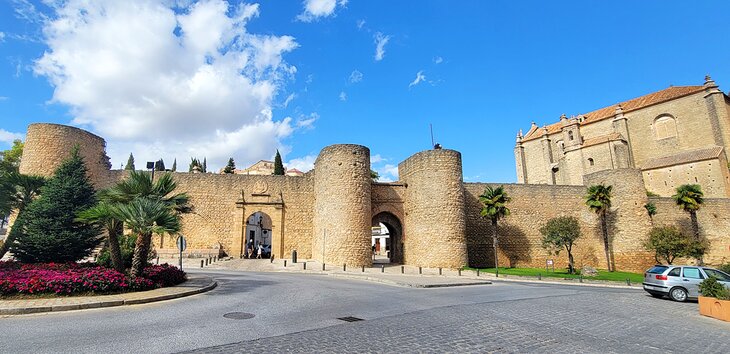
A short stroll from Plaza Duquesa de Parcent and located at the farthest point east in Ronda's old Moorish Town (La Ciudad), the Puerta de Almocábar is a stunning triple entrance gate dating from the 13th century. Rising up from behind the gate and off to the right-hand side is the imposing Iglesia del Espiritu Santo church.
The gate is off the main tourist parade and is a pleasant place to explore. You'll likely have it all to yourself. Climb up to the top of the gate for pleasant views out over the Plaza de San Francisco and the surrounding countryside.
The plaza is a quiet place, with outdoor restaurants serving local cuisine and drinks under a canopy of leafy trees.
Celebrating Heritage: Ronda's Annual Festivals
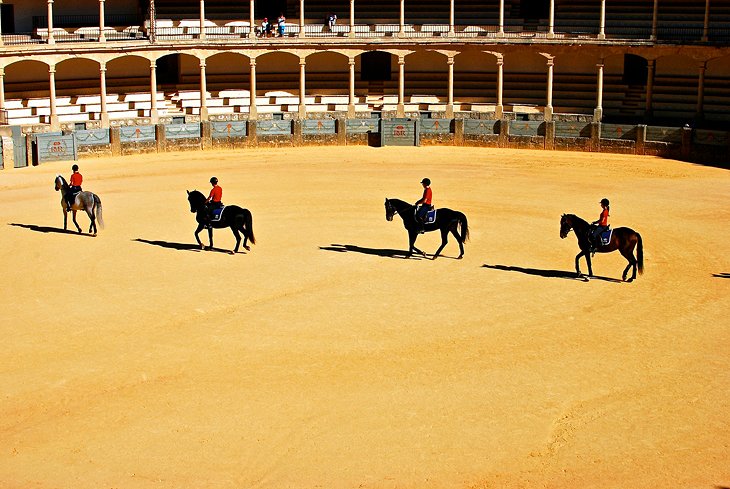
Celebrating Ronda's rural heritage, the Ronda Romantic festival continues the tradition of the Royal May Fair that began in 1509. Local farmers participate in agricultural demonstrations such as goat milking and exhibitions of livestock. The festival also includes equestrian shows, street performances, and live music concerts.
During the first week of September every year, the Feria de Pedro Romero enlivens the city with music, dancing, and singing in honor of Ronda's renowned matador Pedro Romero. The festival begins with a parade of women flamboyantly attired in authentic regional costumes and culminates with the Corrida Goyesca, a traditional bullfight.
The Fiesta de la Virgen de la Paz takes place every year on January 24th. This traditional religious festival includes a parade through the narrow streets of Ronda.
Where can you park in Ronda?
Finding parking in Spanish cities with an old town area can be challenging. The last thing you want to do is end up in a narrow old street with no way of turning around! Fortunately, in Ronda finding parking is actually fairly easy.
The best place to park in Ronda is the huge underground parking lot on Avenida Martinez Astein. The entrance is well marked, and if you are arriving from the north down Avenida de Malaga, you can't miss the entrance. Park here, and all you need to do is walk down the pedestrian-only Carrera Espinel to Virgen de la Paz and take a left.
Another lot, much closer and much more expensive, is located under Plaza del Socorro.
More Related Articles on PlanetWare.com
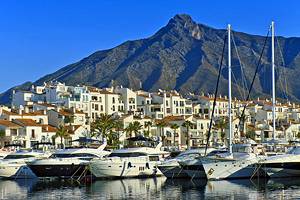
Posh Marbella: Just a little over an hour south of Ronda is the gorgeous seaside resort town of Marbella, located on the Costa del Sol, which is one of the top beach destinations in the Andalusia region. Here, you can find a combination of the old and new, from a historic Moorish old town to high-end beach clubs and golf courses.
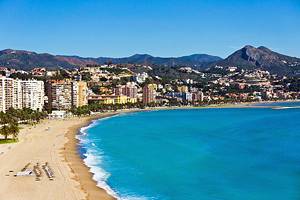
Historic Beaches of Málaga: One of the Mediterranean's oldest resort towns, Málaga is another Costa del Sol beach paradise, home to seaside promenades, as well as the old-world ambience of numerous historic sites, including a 10-century Moorish castle, a Roman theater, and the 13th-century Alcazaba.
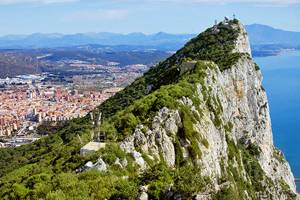
A Taste of Britain: Only four square kilometers in area, the British territory of Gibraltar sits on the west side of the iconic Rock of Gibraltar. Linked to mainland Spain by only a narrow isthmus, the island is known for its incredible views of the busy Strait of Gibraltar; a nature reserve, which is home to Europe's only wild monkeys; and many other excellent natural and cultural attractions.
